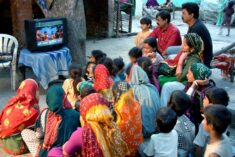By: Kelly Blair
Line21 Media
Think closed captioning can only help if you are hard of hearing? Think again. More and more research is proving that closed captioning has a multitude of uses to benefit everyone. One approach takes captioning into the classroom to help with literacy rates. Same Language Subtitles (SLS) can provide a different approach for teachers who are looking to switch things up and increase engagement. Closed captioning helps “boost foundational reading skills, such as phonics, word recognition, and fluency, for a number of students” (Brann). Motivating children to want to read, especially those who are at a lower reading level, can often be a challenge. Providing TV shows or movies is a fun and different way to expose all students to different versions of text and increase willingness to read. Have you ever found yourself watching something with subtitles, maybe at the gym or doctor’s office, and realized you were reading along? There is a reason why, “eye-tracking research from around the world has established that SLS causes an automatic and inescapable read-along response” (Kothari). This innate tendency can prove crucial to help expand children’s vocabulary and comprehend those words that they might otherwise struggle with. It has been found that “over 94% of teachers now regularly [use] video in the classroom as an effective teaching aid” (“The Missing Piece!”), making the need for captioning more prevalent than ever. Closed captioning requires no extra instruction or time from the teachers, and yet can help literacy rates while simultaneously learning about another topic.
Photo: Planet Read
The introduction of Same Language Subtitles has already been proven to help low literacy rates in India. With a population of over one billion, it was recorded that 778 million people in India were “literate.” Of these 778 million, however, about 389 million people were, at best, “early literate” (Kothari). To address these growing concerns, India looked at utilizing the popularity of Bollywood films. SLS was first implemented in 1999, and has steadily been introduced to more media since then. The results were staggering, “on average, every dollar spent on SLS in India delivers 30 minutes of weekly reading practice to 5,000 weak-readers, for one year” and “even 30 minutes of weekly SLS exposure over 3-5 years, as part of Bollywood film songs, more than doubles the number of functional readers in primary schools” (Kothari).
As the results in India prove, subtitles are not only beneficial in a classroom setting, but also at home. With the ever increasing dependency and attractiveness of technology, captions provide a way to turn that technology time into learning time. SLS provides a way for parents to turn passive TV watching into an educational environment. Closed captioning is not just for those who struggling to read, either. Captioning also helps “reading speed, word knowledge, decoding, reading comprehension, [and] oral reading rates” (Brann), and who doesn’t hate reading in front of the class? The best part of all this research is that you can give it a try at home without any cost to you! Most programs, online videos, and even YouTube already include the captioning option. Give it a try with your little ones and turn family night into family reading night.

- Banks, Ken, and Brij Kothari. “Let a Billion Readers Bloom: How Bollywood Teaches Literacy in India.” National Geographic Society Blogs. N.p., 2012. Web. 17 Oct. 2016
- Brann, Alise. “Captioning to Support Literacy.” Reading Rockets. N.p., 2011. Web. 17 Oct. 2016
- “The Missing Piece!” Academic Benefits of Closed Caption or Subtitles on Educational Video. N.p., n.d. Web. 17 Oct. 2016.

